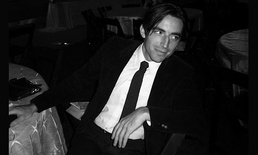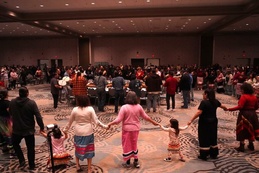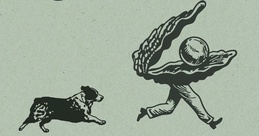A Furrier for the Modern World
Michael Fridrich Henke practices an age-old profession
Aug. 18, 2013

In this world of chain stores and cheap clothing made in Bangladesh, it might seem like an odd and unlikely profession to turn animal hides into hats and coats and vests.
It happens, though, that the fur trade is the Great Lakes region’s oldest profession. The first European settlers came here and established relations with Native Americans to buy and sell furs and trap beaver that could be sold in the east or in Europe.
Now, Michael Fridrich Henke, a third generation furrier, makes his living in Traverse City using the hides of animals indigenous to Northern Michigan -- muskrat, beaver, otter, wild mink, red fox, gray fox, raccoon, opossum, skunk, and ermine.
The Northern Express sat down with Fridrich Henke to discuss his family’s history, his roundabout way back into the furrier business, and having his windshield smashed by anti-fur activists.
Northern Express: This is a family business for you going back three generations. How did your family get into the fur trade business?
Michael Fridrich Henke: My grandfather was a fox farmer. He bought a fox farm in Walled Lake, Michigan. I don’t know exactly the date, but I’m thinking in 1935. Both my grandparents came from Germany.
My grandfather came as an indentured servant, so he worked on a chicken farm for five years. He wouldn’t eat any eggs or poultry after that. But he knew how to farm.
And my grandmother, she was a seamstress. She packed up trunks and trunks; she brought a lot of stuff from Germany.
So my grandfather came with nothing.
My grandmother came with a lot. And they spoke the same language. I’m pretty sure that’s how they met in the Detroit area.
That’s how they got in it. My grandfather raised the fox. My grandmother started making stoles and little pieces and started doing her seamstress work. Then she hired someone to do the fur mechanics and she did more of the hand sewing. There’s still a lot of tedious hand sewing, even today.
NE: And the business was passed on to your father?
Fridrich Henke: My dad grew up on the fox farm. I have pictures of him, holding foxes when he was like five years old, on the fox farm.
It was part of his chores to clean the fox.
The first coat he ever sold, he tracked 40 muskrat and he made and sold the coat. So he did the whole process.
But when my father went to kindergarten, it wasn’t very good for Germans in Michigan. He couldn’t speak English. I think it was 1942. We were at war with Germany. It wasn’t a really good time to be wearing lederhosen to kindergarten. So he got beat up every day. Later, he spoke no German; he has no accent. He didn’t teach us any German. It wasn’t really a positive thing for him.
In the ’50s, he moved up to Flint, because Flint was booming at the time. He got a job at Greenblatt’s, which was a furrier in downtown Flint.
NE: How much has the fur business changed over the years?
Fridrich Henke: The fur business, from the beginning of time, has always been very cyclical. I saw it when I was growing up, it was very cyclical. I mean, there’s three months out of the year that you can actually make a living.
I saw in the late ’80s it changed. People started financing furs. And that was kind of the end for a while. I believe that if people can’t afford furs or luxury pieces, they probably shouldn’t finance them. So the whole customer base changed at that point, and then everybody got casual, ’87-’90, and the fur business just pretty much stopped.
It did the same thing in the ’60s. That’s why there are no young furriers. I used to be a young furrier, now I’m an old furrier, but 25 years ago I was probably the youngest furrier in Michigan. Because their fathers didn’t want them to go into the business. I went to work for General Motors myself.
NE: So as a young man, you didn’t think you would carry on the family tradition?
Fridrich Henke: When I was growing up, this was part of my chores. I had to tear coats apart. I had to nail out skins. It was just a part of something I had to do, like pull weeds in the garden. It was something I had to do that I really didn’t like to do.
The cool thing is, in the early ’70s, we all were wearing ripped pants and torn-up things, and I could actually sew. I would sew on my dad’s fur machine and on the sewing machine.
But no. I thought for sure I would go to college, and that didn’t quite work out for me. So in 1977 I went to work for General Motors. I worked at Plant Four in Flint. It was called "˜the hole.’ I bought a house when I was 19.
NE: What caused you to get back in the fur business?

Fridrich Henke: Probably the fashion of it. I have done a few other things. When the fur business stopped in the mid-’90s, I became a carpenter. I actually made more money as a carpenter than I did as a furrier. I like to work with my hands and do things and see things accomplished. I moved up to Traverse City thinking I would work for another 10 years and retire.
Then the building industry stopped. It’s very cyclical, too. I worked in a factory up here. I worked at Williams Chevrolet, selling Chevys. I worked at Floor Covering Brokers, unloading hardwood flooring.
And then, I saw that the fur business was coming back. Fashion magazines were starting to show more and more fur. And the runways were showing fur. And I think, it’s like, I think it’s going to take off. Timing in any business is critical, so I started this business in the worst economy in 70 years and I did it all old school. I didn’t borrow any money. I work seven days a week. And it’s working out really well.
NE: How is business right now?
Fridrich Henke: I have a job that I have to have ready for a fitting on Wednesday. I have priorities. Right now, I am four months behind. If someone came in and wants something made new, it would be next year until I could even start on it. And that’s a good thing.
NE: Those hats, the animal head hats, are amazing --
Fridrich Henke: As a third-generation master furrier, I never thought I’d be making hats with faces on them. I really started making these hats four years ago.
My dad had done this. My dad is a member of the National Trappers Association, the Michigan Trappers Association, so he does a lot with trappers where he’ll get their skins and make items up. So basically I learned from my dad in the last three or four years, how to do the (animal head) hats.
I used to do a basic, bomber-style hat.
But I really didn’t do any hats with faces on them. They do make a statement. They’re very popular. Right now, the young kids like them too.
NE: Where do the animal pelts come from?
Fridrich Henke: I have a license from the DNR and I buy the furs. I don’t buy them in the retail store, but I do have a shed at home and I do buy them out in the parking lot.
Normally, I do a lot with someone that I’ve made something for. A trapper comes in, I’ll make him a hat or a coat or a blanket. And since he’s a customer, I’d rather buy from him. But then, I’m on the DNR website that shows that I’m a fur buyer, so I get people from all over. But most of my furs I buy from Grand Traverse County and Leelanau County.
So, not only do I know what these furs are, I know that one came from Leelanau County. I know those two skunk skins came from Grand Traverse County, that coyote muff right there came from Leelanau County.
NE: Are you ever involved with trapping?
Are you a hunter?
Fridrich Henke: I do have a harvester’s license, yes. I’m here seven days a week so I really can’t have that fun. I like to be out in the woods, that’s why I moved up to Traverse City.
But being here and this business is taking a lot more time than I thought. I did have a problem with raccoons in my back yard and I did harvest about 20 of them. And I processed them, skin scraped them, stretched them. I know how to do that.
And then I sent them out and got them tanned and then I made a jacket and sold it. So I can actually start from the raw material, have it tanned, make the pattern and sell it.
I don’t know of many other people that can actually go out and dig out the diamond, facet it, set it and sell it.
NE: What’s your experience been like with anti-fur people or animal rights activists?
Fridrich Henke: My history in the 35 years I’ve been doing this professionally is, in the ’80s, I was picketed, I had my tires slashed, I had my windshield broken. But it seems like after 9/11, after the terrorist act, we don’t have the problem of terrorism with animal activists.
I mean, the other thing, too: this is a biodegradable, renewable, sustainable resource. That’s as green as green can be. I mean, I buy local, I sell local. So I think people see anti-fur people for what they really are.
NE: Does the ebb and flow of animal rights activism have any effect on the popularity of fur?
Fridrich Henke: It’s cyclical, you can go back to the Dark Ages when furs were real popular, and then they’re not. So I wouldn’t give any credit to animal activists. They didn’t really stop McDonald’s from killing cows.
So for me, we had the same cycle in the ’60s. It was anti-establishment, anti-fur. There was anti-war, there was a lot of anti- . But those same customers were buying furs in the ’80s, because it was the "˜go-go’ ’80s. They were buying Rolexes. They were buying BMWs. They were buying furs. They were buying McMansions. It was buy-buy-buy n the ’90s, everything stopped.
And people always say, "˜Oh, I wouldn’t wear that because people will throw red paint on me or something.’ I’ve cleaned over half a million coats in the Midwest. I’ve never cleaned red paint off of one coat.
NE: I take it from the way you talk that you love animals.
Fridrich Henke: I love animals. I have dogs, cats, I grew up with animals. And I have Lola, who I bring to work sometimes. I love animals. I enshrine them.
People don’t realize, a red fox, in the wild, maybe lives two years, because it’s looking for food, water, and shelter everyday, and it’s got somebody that wants to eat him every day. Most coyotes don’t eat a cold meal. They eat something alive. And people don’t realize that. I do love animals. I wouldn’t want an animal tortured. I enshrine these animals. I love muskrat. I love to see muskrat swimming.
All the trappers I know, they love animals too. They only want to harvest so much. That’s what man has been doing since the beginning of time.
A trapper doesn’t go in and try to annihilate everything. It would be like eating all of the corn that you grew. You still need some seeds to replant so you can go back and have corn every year. A trapper does the same thing. He knows how many animals are in an area and he takes only so many.
Trending

Our Top Stories of 2025
Each year, we look back at the stories we’ve shared over the last 12 months and pull together the ones that got the mo… Read More >>
A Solo Rattler
Frontman of folk-rock band Michigan Rattlers Graham Young brings his solo performance to Great Lakes Center for the Arts in … Read More >>
GTB Starting the Year with Tradition
The Grand Traverse Band of Ottawa and Chippewa Indians hosts the Kchi Wiikwedong Anishinaabek Maawnjidowin Round Dance on Ja… Read More >>


